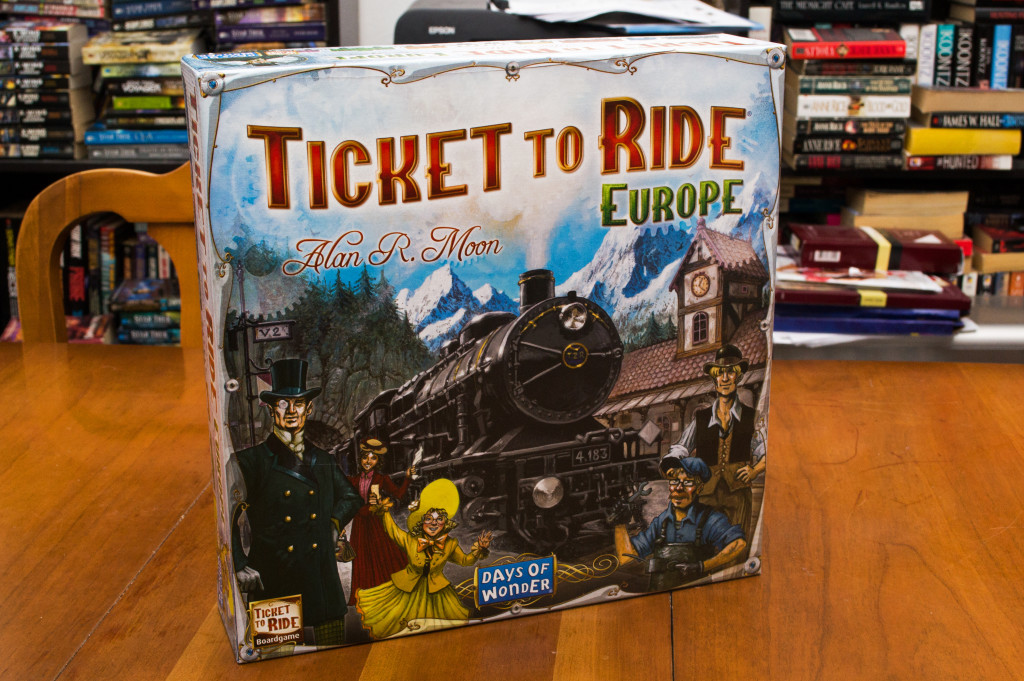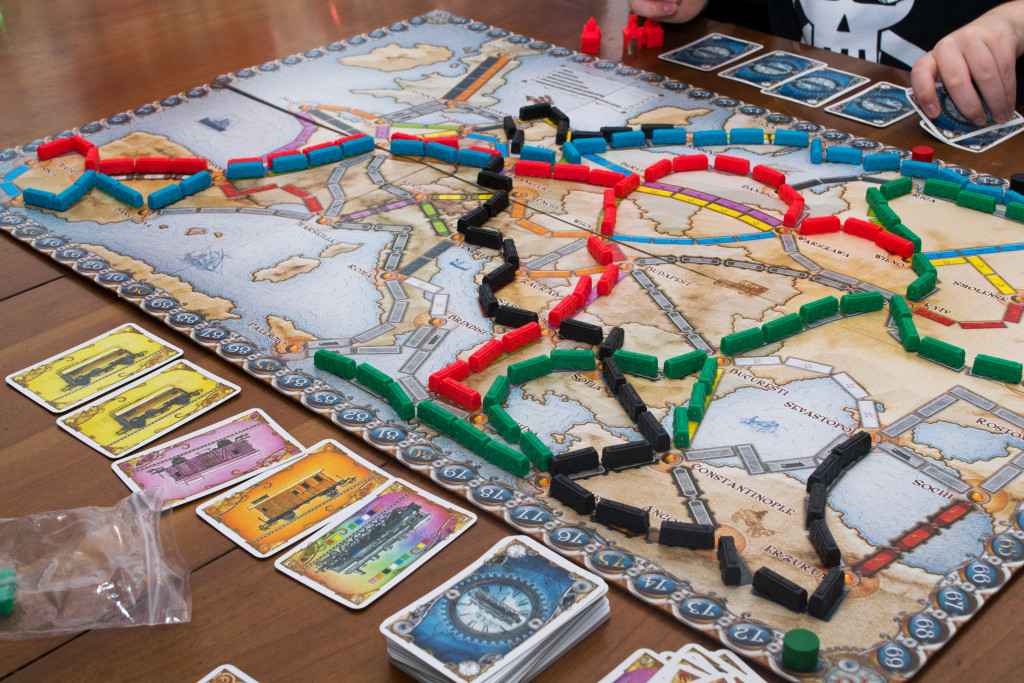Our family has been on a “Ticket to Ride” craze as of late. You’d think one would get tired of matching colors and claiming routes, but there’s just something magical about it that keeps us coming back for more. In addition to picking up the “USA 1910” expansion for the original version, I figured I’d give “Ticket to Ride: Europe” a spin as well. What really interested me were the new mechanics that the USA version didn’t offer…what’s more I was curious to see how the family reacted to them. For the record, I did pick up the “Europa 1912” expansion (which goes with this particular version) and I’ll be covering that in a separate article later.
Components
- 1 map of Europe
- 240 Colored Train Cars (45 each in Blue, Red, Green, Yellow and Black, plus some extra replacement cars in each color)
- 15 Colored Train Stations (three each, matching the trains’ colors)
- 158 Illustrated cards (including train cards, ticket cards, and bonus/summary cards)
- 5 Wooden Scoring Markers (1 each of the 5 players’ colors)
Setup & Gameplay
Players choose a color and receive a set of train cars, three stations of said color, a corresponding score marker, four train cards to form their starting hand, one ticket with a long route (blue background), and three tickets with a regular route (plain background). The remaining long routes are discarded without anyone seeing what they are. Players may keep all of them, but may discard down to two tickets. Five train cards are laid out face-up next to the deck to form an alternate draw pool.
On a player’s turn, they may do ONE of the following:
A) Draw two train cards. You can draw one from the deck and one from the face up pool of train cards, you can draw two from the deck, or two from the face up pool. It’s important to note that should you pick up a wild card from the pool, you will not be allowed to draw a second card.
B) Draw three ticket cards. You decide which ones you wish to discard, if any, but must keep at least one.
C) Play cards to claim a route. To place your trains between two cities, you have to play the exact number of train cards from your hand of that color that connects the two cities. After this is done, move your scoring token up the appropriate amount on the scoring track. The cards you play are discarded. There are some exceptions:
Ferries – These are gray routes that go across a body of water. Any set of colors will do, though these routes typically demand that the player lay down a locomotive (wild) card or two.
Tunnels – Players will attempt to claim the route as normal by laying down the required number of train cards. Before claiming the route however, the player will draw three cards from the deck. For every card drawn that matches the route color (locomotives count), the player will need to lay down that many additional cards of the same color from their hand (or use locomotive cards).
D) Build a Train Station. You may build a station in any city that does not yet have one. The cost to build your first station is one train card, while the cost of building your second or third station requires two/three train cards of the same color, respectively. These allow you to use one (and only one) of your opponent’s routes to or from the city to assist in completing ticket cards.
When one player has two or less trains in his bag, one more turn is played by the rest of the players and the game ends. Players show their ticket cards and add victory points for every connection made and subtract victory points for every connection not made. They also receive four points for every station they didn’t place and factor in the “longest continuous path” bonus. Whoever has the most points after all of that, wins the game!
Editor’s Note: The above is simply an overview and doesn’t cover all of the rules in detail. You can check out the manual for more information here:
http://cdn0.daysofwonder.com/tickettoride/en/img/te_rules_2014-01_en.pdf
The Review
Firstly, let’s quickly cover the new stuff: ferries, tunnels, and stations. It could be my imagination, but the Europe map just seemed to be a bit more condensed and busy. After playing the USA map for so long, I suppose that’s to be expected as the cities on that map just seem to be a bit more spread out. The ferries and tunnels do a good job in limiting how quickly these routes get claimed. In the case of the former, you’ll usually need locomotive cards (which can be hard to come by) while in the case of the latter, you’re taking a risk of either not being able to complete the route or having to spend more train cards than you planned to. It’s possible for one person to get lucky and get the cards they need straight away to complete these trickier routes, luckily the stations help to make up for this.
All in all, “Ticket to Ride: Europe” felt like “Ticket to Ride 2.0”, if that makes any sense. If “Ticket to Ride” were a gateway game to the series, then “Ticket to Ride: Europe” would be the next step up. I haven’t played any of the other games in the series to know if they are more complicated than “Ticket to Ride: Europe” and I’m now curious to see if they are. One option would be to buy the digital DLC packs on Steam, which are much cheaper than their tabletop counterparts. You can learn more about the digital version of Ticket to Ride via my review, though it only covers the USA map. By default, “Ticket to Ride: Europe” features the standard deck-sized cards (“Ticket to Ride”, by default, featured smaller cards later upgraded by the “USA 1910” expansion), so there’s that too.
I gave “Ticket to Ride” a 10/10 for plenty of good reasons and I’m pleased to say that “Ticket to Ride: Europe” will be getting the same score. It stinks that these different maps cost about $40-50 a pop (again, the digital DLC packs are cheaper), so adding every “Ticket to Ride” variant to your collection could cost you $150-$200 and up. This may feel like eye-gouging to some, but regular “Ticket to Ride” players will get their money’s worth and then some out of this entry. If you’re new to the series as a whole, I’d recommend starting with the standard “Ticket to Ride” (USA map) to see if the gameplay mechanics interest you. Granted, this version is very similar, but the extra rules and features make it a bit more complicated. In theory, you could play “Ticket to Ride: Europe” using original “Ticket to Ride” rules if you fancy using the Europe map over the USA…though I’d recommend this for players who already know what they’re doing.
Editor’s Note: Have suggestions or recommendations for my next “Ticket to Ride” experience? Feel free to leave a comment…I’m eyeing the “card game” and “Marklin”, but the jury is still out.
Final Verdict: 10/10
—



